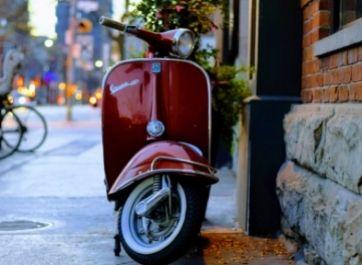This site uses cookies to provide you with a better experience. By clicking on "Accept" all categories of cookies will be activated. To decide which ones to accept, click on "Customize" instead. For more information you can consult the page *** Cookie policy.
How to restore a Vespa
Posted on 23.06.2021How to restore a vintage Vespa? The best solution is to turn to highly qualified personnel accustomed to working on these two wheels that have marked the history of Italy. In fact, great skill is needed to bring an 'old' Vespa back to its former glory, but above all it requires historical knowledge, great passion and a lot of love. Not all Vespa models need the same care. Not all scooters have shown the same problems over time. Some need a real mechanic, others need an auto electrician to restart the engine and brake and light systems. Still others, however, need an expert body builder who can eliminate rust and find the right color for that particular model. Another important thing besides that of turning to professionals of the trade? Know exactly the history of your Vespa, but above all its characteristics. Indeed, many Vespa models have come out. Over the years the 50 Special has undergone several evolutions. It would be a huge mistake to restore a Vespa by adding anachronistic details with its history. This is why it becomes very important, through the chassis number, to trace the characteristics of your vehicle. Thanks to the internet and the presence of numerous experts in the history of the Vespa, there are nowadays numerous technical sheets ready to tell, detail after detail, each model in the smallest details and to explain why certain choices were made regarding the technical and the frame.
How to disassemble a Vespa: the first step of the restoration
The first step to know how restore a Vespa with all the necessary spare parts that of completely disassembling the Piaggio scooter, taking care of every piece, even the smallest. By observing the best professionals in the field, it can be seen how these, in addition to the great attention to all the various components, then arrange the pieces on the worktop in an orderly manner according to the subsequent interventions to be made. We need order and method, but above all we need expert hands able to predict, already during this phase, what the next steps will be and what care will be required for the restoration of the Vespa. There are pieces of the bodywork that will have to follow certain processes, while pieces that will immediately end up in the hands of the mechanic for a thorough cleaning or a complete change. In this phase of disassembly of the historic scooter that made Italian design famous in the world, it is also important to use the right tools to avoid further damaging the various parts of the Vespa and causing new damage to those already created by the passing of the years and by the usury.How to restore a Vespa: all the attention to be paid to the frame
Step number two? In the second phase of restoration of a Vespa, great care must be taken for the chassis of the vintage vehicle. This is why good frame sandblasting is important. Only through this phase it is possible to carry out a precise analysis of the situation before applying the same paint color that has sanctioned its history. It is also necessary to check very carefully, during this phase, the damage created by rust. If it has remained on the surface, things can be resolved in a few moves. If, on the other hand, the rust has affected important parts, it might be good to start looking on the internet or from experienced dealers, for some parts to replace. The body builder certainly takes care of the frame of the Vespa. It is up to him to study its history and characteristics and restore all its components without making mistakes. We emphasize this precisely because in the restoration of a Vespa you have to try everything to keep the original paint and components of the vehicle without changes or transformations. In fact, true lovers of the vehicle argue that the restoration should not alter its intrinsic characteristics and should simply be limited to polishing, cleaning and restoring the parts of the scooter, checking the mechanical and electrical parts, leaving visible the signs and the wear of time. There are vehicles, however, which have suffered greater damage over time and which require more extensive interventions to be restored to their former glory. Even if reluctantly it is very often necessary to replace some parts and repaint parts of the frame trying to stick to the original characteristics as faithfully as possible. Also on the internet you can find the color codes of vintage Vespas with a couple of clicks. You can use the same colors of the past, in the same shades. An example? The Vespa 125 VM2T had Max Meyer 15048 Gray nitro paint. What must be checked before painting? That the frame is smooth and that an ad hoc product has been passed over it for protection and maintenance. How many coats of paint must be applied? It goes from 3 to 4. If you are not an expert, however, and especially if you do not have a good compressor, it is advisable to let a professional paint the vehicle.From the engine to the electronics to finish the assembly: here's how to restore a Vespa
Once the frame has been arranged, once the various parts have been chromed, we then move on to overhauling and rectifying the cylinder, cleaning the carburetor and replacing all worn parts. Definitely: gaskets and muffler, which fortunately are still in production, will have to be changed. In the last phase of the restoration of a vintage Vespa, the mechanic and auto electrician work together to reassemble the various pieces and fix the electrical system, checking the regular functioning of each component. The study of the Vespa model that is being restored, even in this phase, is really important. Not all scooters had, for example, position lights, or warning lights on the headlight but above all not all models used the headlight on the front fender.Latest Headlines
- Discover the potential of the Stelvio 177 cylinder for your Vespa PX: a detailed guide Posted on 26.01.2024
- From the origins to the present day: The evolution of the Vespa 125 over the years Posted on 07.11.2023
- The disc brake kit: an essential upgrade for your Vespa 50 Special Posted on 18.10.2023
- How the Polini 130 cylinder can improve the performance of your Vespa Posted on 18.10.2023
- Buying guide for the Vespa 125 ET3: everything you need to know Posted on 17.10.2023
Search the Blog








